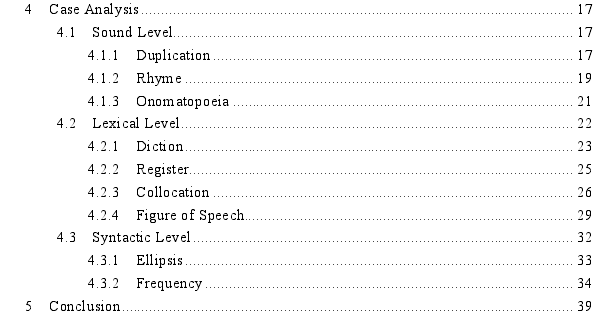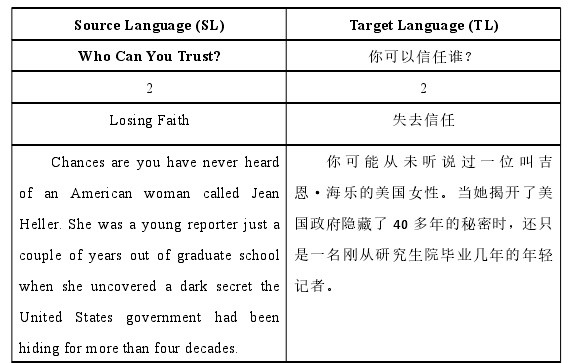英语论文哪里有?在本报告中,二十四节气的春季部分被选为翻译文本。作者从三个层面分析了原文的审美信息,即声音层面、词汇层面和句法层面。在翻译美学的指导下,这种审美效果被成功地呈现或转移到其他类型的美学中。
1 Introduction
1.2 Main Content of the Source Text
Chinese National Culture Classics: the Twenty-four Solar Terms was written by Yu Yaodong in 2012, and published by Huangshan Publisher. This book mainly introduces the origin, background, custom and festivals of the twenty-four solar terms, including lots of proverbs and poems. This book consists of four parts of spring, summer, autumn, and winter, about 60 thousand Chinese characters totally. The author selects spring part as source text, with a total of about 15 thousand Chinese characters, which includes six solar terms: Start of Spring, Rain Water, Awakening of Insects, Spring Equinox, Clear and Bright, and Grain Rain.
The detailed description of the twenty-four solar terms, the explanation of farming, seasonal changes, folk customs, lunar festivals and other aspects in the book impart a lot of knowledge to readers. Not only does it sensitize the power of the traditional Chinese culture, but also it strengthens the cohesive force and emotional appeal of the Chinese nation. The book tells Chinese stories, contributes to spread the unique traditional Chinese culture.

3 Translation Process
3.1 Pre-translation
Adequate preparation is the prerequisite for its subsequent work. For scholars, no research can be completed without adequate preparation. The same is true for the author. Out of love for Chinese traditional culture, the author searched related literature about ancient Chinese cultural classics on academic websites such as China National Knowledge Infrastructure, Wan Fang Data Knowledge Service Platform and so on. After careful comparison and selection, the author finally chose the book Chinese Traditional Culture Classic: the Twenty-four Solar Terms, written by Yu Yaodong as the final practical text, which mainly introduces the Chinese The twenty-four solar terms. The language style of this book is concise and full of beauty, so the author decided to choose Liu’s Translation Aesthetics as theoretical basis. In this situation, the author also read Introduction to Translation Aesthetics and Mao’s Translation Aesthetics, and consulted a large number of relevant literature to consolidate theoretical basis.
Translation theory is very important in the entire translation process. The concept of Translation Aesthetics is a relatively new theory proposed by domestic scholar, Professor Liu, in his book An Introduction to Translation and Aesthetics, which not only enriched the translation theory system but also greatly promoted the development of translation theory in China. From an aesthetic perspective, translation is the reproduction of the aesthetic value of the original text. The source language and target language are aesthetic objects and the author is an aesthetic subject, and these build the basic framework of Translation Aesthetics in the dynamic role of the subject and object. Professor Liu proposed formal system and discussed the aesthetic objects from sound, characters, lexicon, syntax, and paragraphs. According to the language features, this practice analyzes aesthetic effect on sound, lexicon, and syntax.
4 Case Analysis
4.1 Sound Level
According to Liu Mi, sound is one of the basic forms of musicality bearing the aesthetic information of language. Wang pointed out that “the prosody and rhythm of prose are mainly manifested by means of alliteration, end rhyme, repetition and parallel sentences, and a large number of four-character words and duplicated words are used in Chinese language”.[35] Though this source text is not prose, there are many proverbs and poetry containing beauty. So the author should choose appropriate rhetorical devices to retain these features as much as possible and reproduce beauty of sound and rhyme of the source text. In the ST, there are several kinds of sound beauty, mainly embodied in duplication, rhyme, and onomatopoeia, and some samples of sound beauty are analyzed as follows:
4.1.1 Duplication
Liu said, as for beauty in sound, duplication has been applied in the Book of Songs. On account of the feature of Chinese, it is extremely universal to employ duplication, which plays a special role in embodying the beauty in sound. There are many duplicated words in Chinese, which are catchy, enrich language and convey the beauty of language. However, in the translation process, it’s a real bump to realize the same sound beauty with the source text. Thus, when it’s impossible to retain the artistic effect in the TT, giving up something or transferring the aesthetic values is necessary.
4.2 Lexical Level
According to Liu, lexicon is one of the most important and basic units that can carry aesthetic information in source text. And there are several aspects in wording: diction, register, collocation, including conventional and unconventional collocation, and figure of speech, an active application loading aesthetic information. For the first aspect, he proposed “ABC principle” for aesthetics in lexical level: Appropriateness, for exact delivery of original intention, and orientation of context; Beauty, the quality of being able to give great pleasure to the mind of senses; Compactness, avoiding worthless expatiation. It can be found that almost all masterpieces at all times and in all over the world conform to the “ABC principle”.
4.2.1 Diction
Based on “ABC principle”, diction plays an important role in carrying aesthetic information in lexical level, and delicate diction must be elaborately selected by the author of the source text, which should be paid much attention in translation.
Sample 8 Appropriateness
ST: “春雷响,万物长”,惊蛰时节正是大好的“九九”艳阳天,气温回升,雨水增多。
TT: “Spring thunder booms, everything begins to grow”. The timing of Awakening of Inserts is just the “JiuJiu” gorgeous days, with rebounded temperature and increasing rainfall. (The ninth nine-day after Winter Solstice. Counting nine-day is a method of calculating the cold days in ancient folk, counting from the day of Winter Solstice, each nine days is counted as a “nine-day”, such as the first nine-day, the second nine-day and so on. The coldest period of the year is “first three nine-days”. Counting up to the eighty-first day, spring is coming and everything is full of vitality. Thus, it is time for spring cultivation.)

5 Conclusion
5.1 Major Findings
In this report, the spring part of the twenty-four solar terms is selected as translation text. The author has analyzed the aesthetic information of the source text from three levels, namely sound level, lexical level, and syntactic level. Under the guidance of Translation Aesthetics, the aesthetic effect is presented successfully or transferred to other type of aesthetics.
Firstly, in sound level, the factors bearing aesthetic information include duplication, rhyme, and onomatopoeia. The aesthetic effect in the TT is presented successfully for end rhyming and onomatopoeia, with the translation techniques of explicitness, clause structure change, sentence structure change for end rhyming, and literal translation for onomatopoeia. All of these realize musicality and sense of rhythm in the translation. In contrast, the aesthetic effect is not retained in duplication, but be compensated by alliteration and end rhyming in the translation, presenting sound beauty as well.
Secondly, in lexical level, the objects carrying aesthetic information contain diction, register, collocation and figure of speech, all of which conform to “ABC principle”, namely appropriateness, beauty, compactness. From the perspective of diction, the aesthetic effect of appropriateness is represented by expansion, by which the original meaning is accurately expressed. Then the principle of beauty is reproduced by literal translation to show beautiful elements in culture in the TT. And compactness is realized by literal translation.
As for register, appropriateness is a basic principle to be realized in translation. On the basis of appropriateness, more attention is paid to represent the aesthetic effect of beauty and compactness, which adopts paraphrase and culture filtering in this practice.
reference(omitted)

